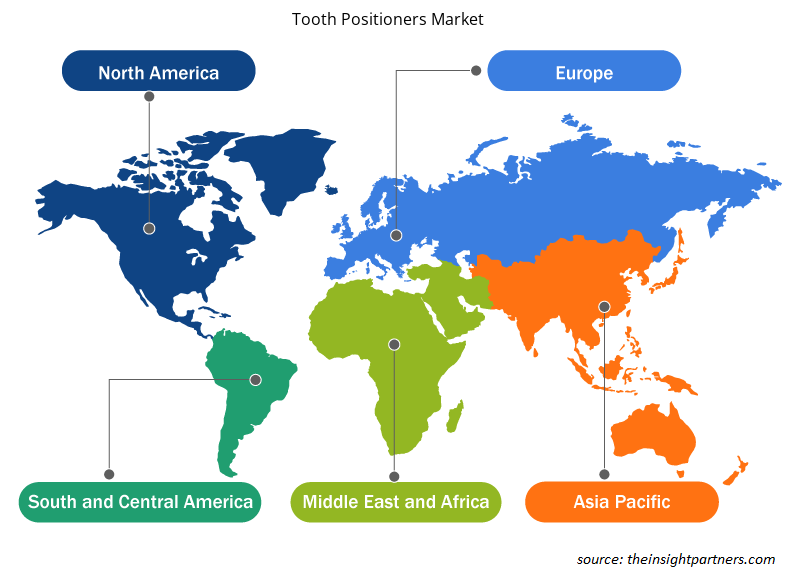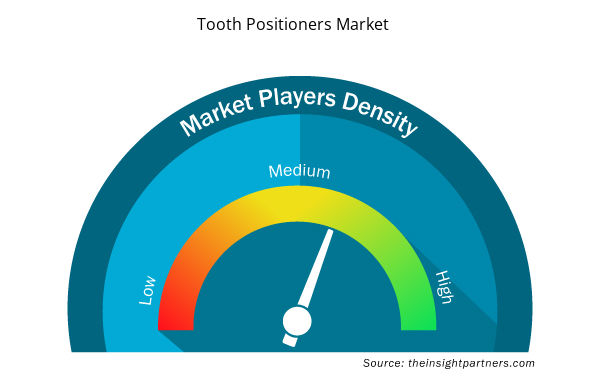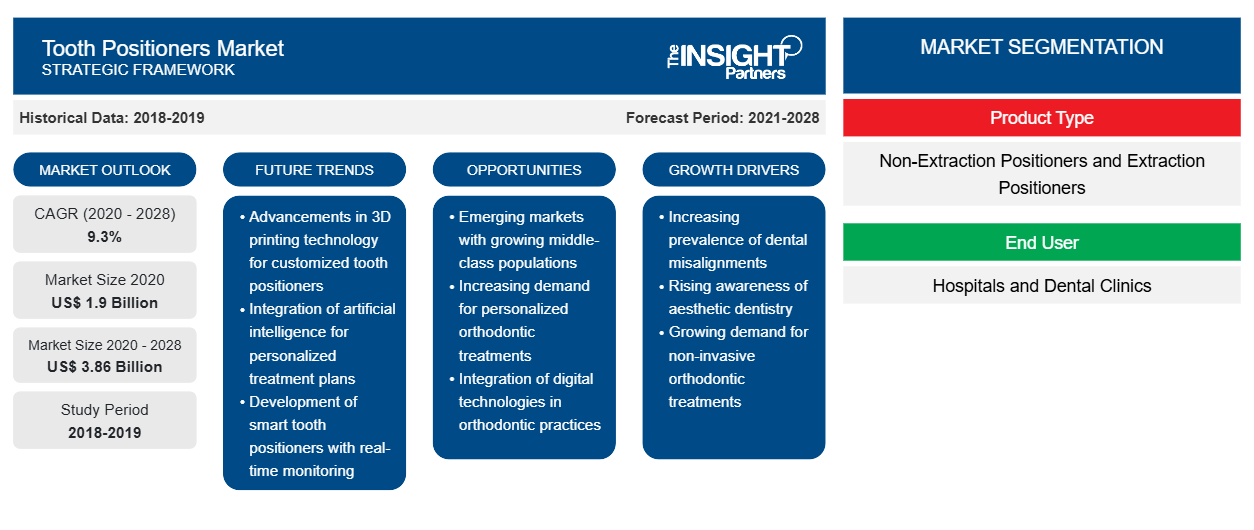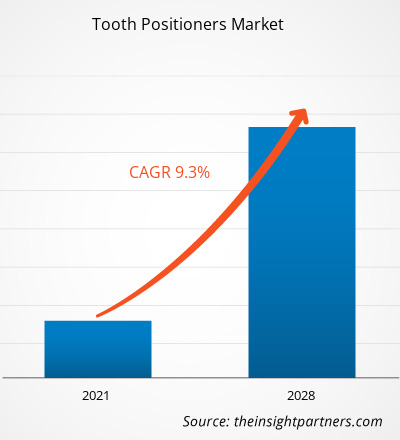Il mercato dei posizionatori dentali è stato valutato a 1.901,91 milioni di dollari nel 2020 e si prevede che raggiungerà i 3.855,65 milioni di dollari entro il 2028; si prevede una crescita a un CAGR del 9,3% nel periodo 2021-2028.
I posizionatori dentali sono noti apparecchi ortodontici formati da un corpo a forma di arco di un materiale resiliente (Silastic); si adattano perfettamente alla bocca del paziente tra l'arcata superiore e quella inferiore. Sono utilizzati per controllare l'assestamento dentale e per ridurre al minimo o eliminare la recidiva dei denti dopo un trattamento ortodontico.
La crescente prevalenza di problemi dentali spinge all'adozione di sistemi di posizionamento dei denti. Le malattie dentali e orali colpiscono le persone almeno una volta nella vita. Il semplice mal di denti può causare dolore insopportabile, disagio e deturpazione. Secondo il rapporto dell'American Dental Association pubblicato nel 2019, il 50,4% dei bambini con Medicaid o CHIP e il 67,1% dei bambini con assicurazione privata hanno avuto visite dal dentista nel 2016. La malattia parodontale, che provoca la perdita dei denti, è all'11° posto tra le malattie dentali più diffuse al mondo. La prevalenza di condizioni dentali e orali come morsi profondi, denti storti, morsi inversi, morsi incrociati, spazi tra i denti, affollamento dei denti e disturbi temporomandibolari (TMD) è in aumento in tutto il mondo. I principali fattori che portano a problemi dentali includono lesioni, malattie parodontali, incidenti e altri. Secondo i dati della Canadian Association of Orthodontists, circa 4 milioni di persone in Canada e negli Stati Uniti stanno ricevendo cure da uno specialista ortodontico. Inoltre, secondo i dati dei Centers for Disease Control and Prevention (CDC), circa il 31,6% della popolazione degli Stati Uniti ha avuto carie dentali non trattate nel periodo 2013-2016. Inoltre, secondo un rapporto di indagine pubblicato nel 2018, il 62% dei soggetti si è recato dal dentista almeno una volta nel 2016 e, mentre il 62% di loro ha avuto almeno una visita dal dentista nel 2017, il 52% ha preso l'appuntamento più recente per un controllo regolare. Pertanto, la crescente prevalenza di problemi dentali guida la crescita del mercato dei posizionatori dentali
Personalizza questo report in base alle tue esigenze
Riceverai la personalizzazione gratuita di qualsiasi report, comprese parti di questo report, o analisi a livello nazionale, pacchetto dati Excel, oltre a usufruire di grandi offerte e sconti per start-up e università
- Scopri le principali tendenze di mercato in questo rapporto.Questo campione GRATUITO includerà analisi di dati che spaziano dalle tendenze di mercato alle stime e alle previsioni.
Approfondimenti di mercato
La medicina odontoiatrica estetica è una delle procedure cosmetiche più comuni al mondo. L'American Academy of Dentistry (AACD) è la risorsa principale per i pazienti che vogliono mantenere il loro benessere, le loro prestazioni lavorative e il loro aspetto. In linea con l'American Society for Cosmetic Surgery (ASPS), l'odontoiatria ha registrato un recente boom con un aumento del 47% delle procedure richieste dalle persone di età compresa tra 51-64 e 64 anni. I costi della cosmetica dentale sono inferiori nei paesi nordamericani. Le procedure tipiche dei dentisti estetici e le procedure principali dei dentisti estetici nei paesi nordamericani hanno una differenza di costo di circa 50-150 $ USA per corona o faccetta. I dentisti in Messico hanno laboratori di alta qualità e forniscono corone economiche.
Prodotti: Approfondimenti tecnologici
Il mercato globale dei posizionatori dentali, in base al tipo di prodotto, è diviso in posizionatori non estrattivi e posizionatori estrattivi. Il segmento dei posizionatori non estrattivi ha detenuto una quota maggiore del mercato nel 2020. Tuttavia, si prevede che lo stesso segmento registrerà un CAGR più elevato nel mercato durante il periodo di previsione.
Utente finale:
In base all'utente finale, il mercato globale dei posizionatori dentali è segmentato in ospedali e cliniche odontoiatriche. Il segmento degli ospedali ha detenuto la quota maggiore del mercato nel 2020 e si prevede che il segmento delle cliniche odontoiatriche registrerà il CAGR più elevato nel periodo 2021-2028.
Gli operatori che operano nel mercato dei posizionatori dentali adottano strategie di collaborazione e partnership per soddisfare le esigenze degli utenti finali attraverso l'introduzione di offerte tecnologicamente avanzate; queste strategie supportano in modo significativo la crescita del mercato.
Approfondimenti regionali sul mercato dei posizionatori dentali
Le tendenze regionali e i fattori che influenzano il mercato dei posizionatori dentali durante il periodo di previsione sono stati ampiamente spiegati dagli analisti di Insight Partners. Questa sezione discute anche i segmenti e la geografia del mercato dei posizionatori dentali in Nord America, Europa, Asia Pacifico, Medio Oriente e Africa e Sud e Centro America.

- Ottieni i dati specifici regionali per il mercato dei posizionatori dei denti
Ambito del rapporto di mercato sui posizionatori dei denti
| Attributo del report | Dettagli |
|---|---|
| Dimensioni del mercato nel 2020 | 1,9 miliardi di dollari USA |
| Dimensioni del mercato entro il 2028 | 3,86 miliardi di dollari USA |
| CAGR globale (2020 - 2028) | 9,3% |
| Dati storici | 2018-2019 |
| Periodo di previsione | 2021-2028 |
| Segmenti coperti | Per tipo di prodotto
|
| Regioni e Paesi coperti | America del Nord
|
| Leader di mercato e profili aziendali chiave |
|
Densità dei player del mercato dei posizionatori dentali: comprendere il suo impatto sulle dinamiche aziendali
Il mercato dei posizionatori dentali sta crescendo rapidamente, spinto dalla crescente domanda degli utenti finali dovuta a fattori quali l'evoluzione delle preferenze dei consumatori, i progressi tecnologici e una maggiore consapevolezza dei vantaggi del prodotto. Con l'aumento della domanda, le aziende stanno ampliando le loro offerte, innovando per soddisfare le esigenze dei consumatori e capitalizzando sulle tendenze emergenti, il che alimenta ulteriormente la crescita del mercato.
La densità degli operatori di mercato si riferisce alla distribuzione di aziende o società che operano in un particolare mercato o settore. Indica quanti concorrenti (operatori di mercato) sono presenti in un dato spazio di mercato in relazione alle sue dimensioni o al valore di mercato totale.
Le principali aziende che operano nel mercato dei posizionatori dentali sono:
- Ortodonzia TP, Inc.
- Allineare l'ortodonzia
- Laboratorio ortodontico Dockstader, Inc.
- DENTAURUM GmbH & Co. KG
- 3 milioni
Disclaimer : le aziende elencate sopra non sono classificate secondo un ordine particolare.

- Ottieni una panoramica dei principali attori del mercato dei posizionatori dentali
Per tipo di prodotto
- Posizionatori senza estrazione
- Posizionatori di estrazione
Per utente finale
- Ospedali
- Cliniche dentali
Per Geografia
America del Nord
- NOI
- Canada
- Messico
Europa
- Francia
- Germania
- Italia
- Regno Unito
- Spagna
Asia Pacifico
- Cina
- India
- Corea del Sud
- Giappone
- Australia
Medio Oriente e Africa
- Sudafrica
- Arabia Saudita
- Emirati Arabi Uniti
America del Sud e Centro
- Brasile
- Argentina
Profili aziendali
- Ortodonzia TP, Inc.
- Allineare l'ortodonzia
- Laboratorio ortodontico Dockstader, Inc.
- DENTAURUM GmbH & Co. KG
- 3 milioni
- DENTSPLY Sirona
- Ortodonzia G&H
- DinaFlex
- Laboratori odontoiatrici Protec
- Laboratori odontoiatrici Johns
- Analisi storica (2 anni), anno base, previsione (7 anni) con CAGR
- Analisi PEST e SWOT
- Valore/volume delle dimensioni del mercato - Globale, regionale, nazionale
- Industria e panorama competitivo
- Set di dati Excel



Report Coverage
Revenue forecast, Company Analysis, Industry landscape, Growth factors, and Trends

Segment Covered
This text is related
to segments covered.

Regional Scope
North America, Europe, Asia Pacific, Middle East & Africa, South & Central America

Country Scope
This text is related
to country scope.
Domande frequenti
The uneasiness and inconvenience caused by tooth positioners is the significant factor that will hinder the tooth positioners market growth.
The global tooth positioners market is being driven by factors such as rising prevalence of dental problems and increase in demand for dental cosmetic procedures are likely to offer significant opportunities for the growth of the global tooth positioners market.
TP Orthodontics, Inc., Align Orthodontics, Dockstader Orthodontic Lab, Inc., DENTAURUM GmbH & Co. KG, 3M, DENTSPLY GAC International, G&H Orthodontics, DynaFlex, LM-Instruments Oy., Johns Dental Laboratories and among others are major companies operating in this market.
Trends and growth analysis reports related to Life Sciences : READ MORE..
The List of Companies - Tooth Positioners Market
- TP Orthodontics, Inc.
- Align Orthodontics
- Dockstader Orthodontic Lab, Inc.
- DENTAURUM GmbH & Co. KG
- 3M
- DENTSPLY Sirona
- G&H Orthodontics
- DynaFlex
- Protec Dental laboratories
- Johns Dental Laboratories
The Insight Partners performs research in 4 major stages: Data Collection & Secondary Research, Primary Research, Data Analysis and Data Triangulation & Final Review.
- Data Collection and Secondary Research:
As a market research and consulting firm operating from a decade, we have published and advised several client across the globe. First step for any study will start with an assessment of currently available data and insights from existing reports. Further, historical and current market information is collected from Investor Presentations, Annual Reports, SEC Filings, etc., and other information related to company’s performance and market positioning are gathered from Paid Databases (Factiva, Hoovers, and Reuters) and various other publications available in public domain.
Several associations trade associates, technical forums, institutes, societies and organization are accessed to gain technical as well as market related insights through their publications such as research papers, blogs and press releases related to the studies are referred to get cues about the market. Further, white papers, journals, magazines, and other news articles published in last 3 years are scrutinized and analyzed to understand the current market trends.
- Primary Research:
The primarily interview analysis comprise of data obtained from industry participants interview and answers to survey questions gathered by in-house primary team.
For primary research, interviews are conducted with industry experts/CEOs/Marketing Managers/VPs/Subject Matter Experts from both demand and supply side to get a 360-degree view of the market. The primary team conducts several interviews based on the complexity of the markets to understand the various market trends and dynamics which makes research more credible and precise.
A typical research interview fulfils the following functions:
- Provides first-hand information on the market size, market trends, growth trends, competitive landscape, and outlook
- Validates and strengthens in-house secondary research findings
- Develops the analysis team’s expertise and market understanding
Primary research involves email interactions and telephone interviews for each market, category, segment, and sub-segment across geographies. The participants who typically take part in such a process include, but are not limited to:
- Industry participants: VPs, business development managers, market intelligence managers and national sales managers
- Outside experts: Valuation experts, research analysts and key opinion leaders specializing in the electronics and semiconductor industry.
Below is the breakup of our primary respondents by company, designation, and region:

Once we receive the confirmation from primary research sources or primary respondents, we finalize the base year market estimation and forecast the data as per the macroeconomic and microeconomic factors assessed during data collection.
- Data Analysis:
Once data is validated through both secondary as well as primary respondents, we finalize the market estimations by hypothesis formulation and factor analysis at regional and country level.
- Macro-Economic Factor Analysis:
We analyse macroeconomic indicators such the gross domestic product (GDP), increase in the demand for goods and services across industries, technological advancement, regional economic growth, governmental policies, the influence of COVID-19, PEST analysis, and other aspects. This analysis aids in setting benchmarks for various nations/regions and approximating market splits. Additionally, the general trend of the aforementioned components aid in determining the market's development possibilities.
- Country Level Data:
Various factors that are especially aligned to the country are taken into account to determine the market size for a certain area and country, including the presence of vendors, such as headquarters and offices, the country's GDP, demand patterns, and industry growth. To comprehend the market dynamics for the nation, a number of growth variables, inhibitors, application areas, and current market trends are researched. The aforementioned elements aid in determining the country's overall market's growth potential.
- Company Profile:
The “Table of Contents” is formulated by listing and analyzing more than 25 - 30 companies operating in the market ecosystem across geographies. However, we profile only 10 companies as a standard practice in our syndicate reports. These 10 companies comprise leading, emerging, and regional players. Nonetheless, our analysis is not restricted to the 10 listed companies, we also analyze other companies present in the market to develop a holistic view and understand the prevailing trends. The “Company Profiles” section in the report covers key facts, business description, products & services, financial information, SWOT analysis, and key developments. The financial information presented is extracted from the annual reports and official documents of the publicly listed companies. Upon collecting the information for the sections of respective companies, we verify them via various primary sources and then compile the data in respective company profiles. The company level information helps us in deriving the base number as well as in forecasting the market size.
- Developing Base Number:
Aggregation of sales statistics (2020-2022) and macro-economic factor, and other secondary and primary research insights are utilized to arrive at base number and related market shares for 2022. The data gaps are identified in this step and relevant market data is analyzed, collected from paid primary interviews or databases. On finalizing the base year market size, forecasts are developed on the basis of macro-economic, industry and market growth factors and company level analysis.
- Data Triangulation and Final Review:
The market findings and base year market size calculations are validated from supply as well as demand side. Demand side validations are based on macro-economic factor analysis and benchmarks for respective regions and countries. In case of supply side validations, revenues of major companies are estimated (in case not available) based on industry benchmark, approximate number of employees, product portfolio, and primary interviews revenues are gathered. Further revenue from target product/service segment is assessed to avoid overshooting of market statistics. In case of heavy deviations between supply and demand side values, all thes steps are repeated to achieve synchronization.
We follow an iterative model, wherein we share our research findings with Subject Matter Experts (SME’s) and Key Opinion Leaders (KOLs) until consensus view of the market is not formulated – this model negates any drastic deviation in the opinions of experts. Only validated and universally acceptable research findings are quoted in our reports.
We have important check points that we use to validate our research findings – which we call – data triangulation, where we validate the information, we generate from secondary sources with primary interviews and then we re-validate with our internal data bases and Subject matter experts. This comprehensive model enables us to deliver high quality, reliable data in shortest possible time.


 Ottieni un campione gratuito per questo repot
Ottieni un campione gratuito per questo repot